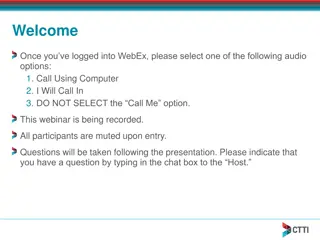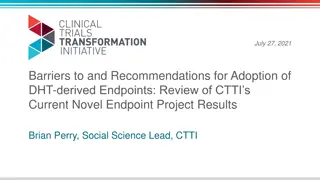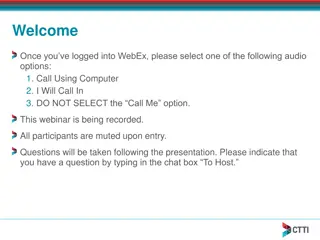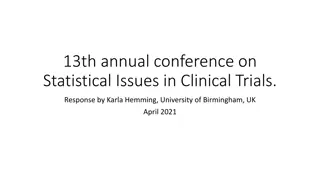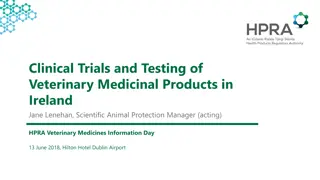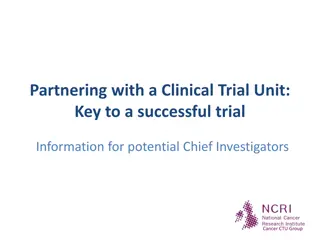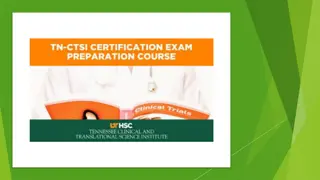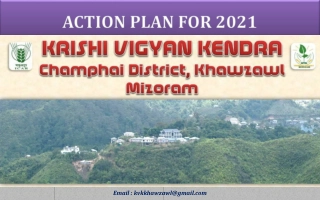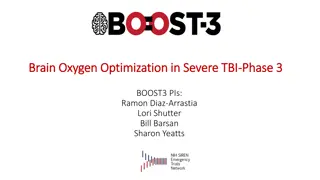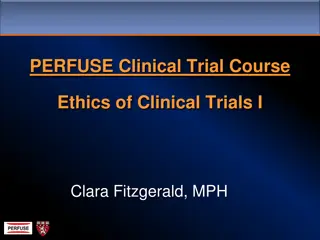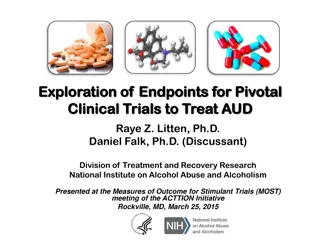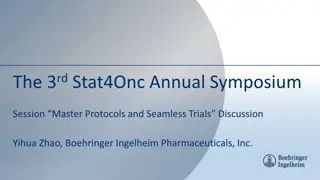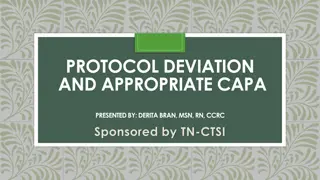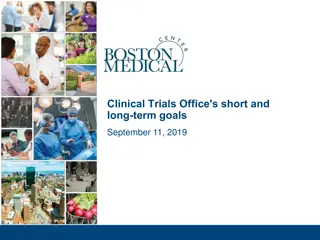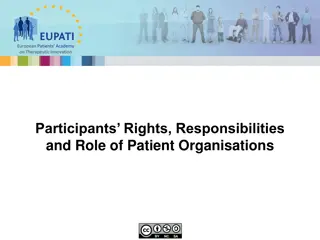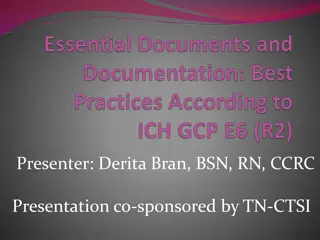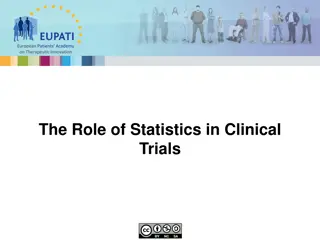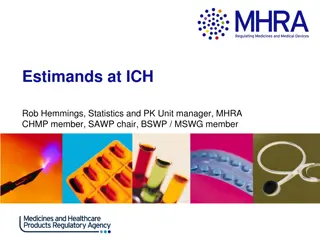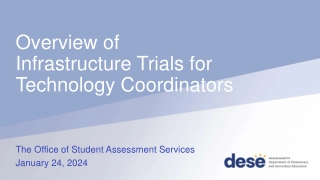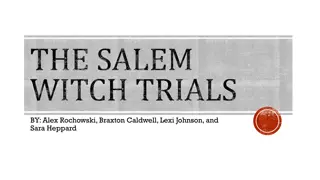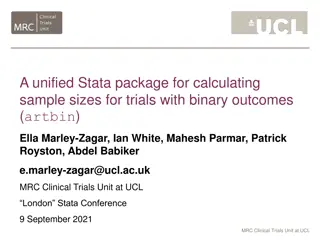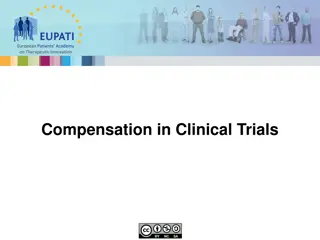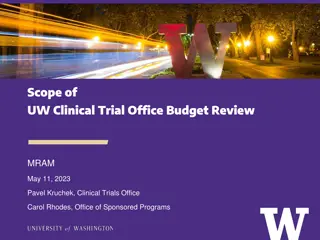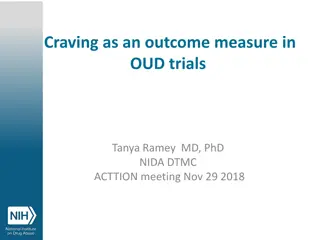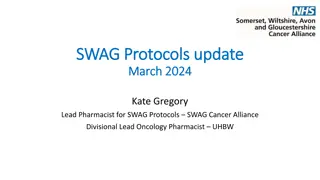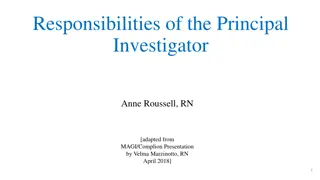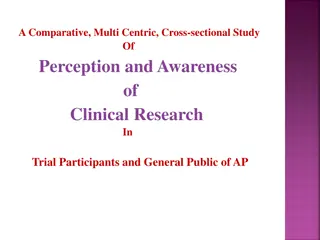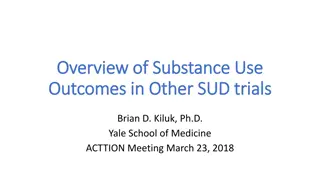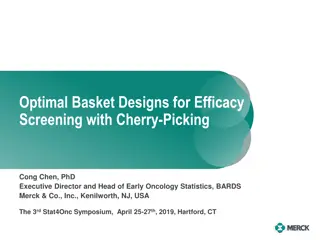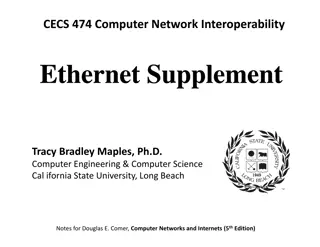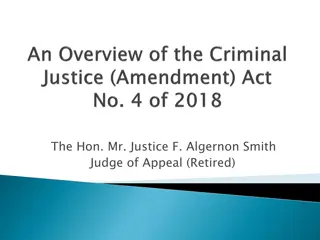Enhancing Clinical Trials Through Master Protocols: CTTI Webinar Insights
Explore the latest resources and strategies for designing and implementing master protocols in clinical trials. Learn from experts on best practices, patient-centered design, stakeholder alignment, and problem-solving approaches. Discover the mission of CTTI and the VeloCTTI project methodology aimed at improving trial efficiency and quality. Gain valuable insights from a multi-stakeholder partnership co-founded by Duke University and the FDA.
Download Presentation

Please find below an Image/Link to download the presentation.
The content on the website is provided AS IS for your information and personal use only. It may not be sold, licensed, or shared on other websites without obtaining consent from the author. Download presentation by click this link. If you encounter any issues during the download, it is possible that the publisher has removed the file from their server.
E N D
Presentation Transcript
Welcome: New Resources for Designing & Running Master Protocols This webinar is being recorded and will be posted to the CTTI website All participants are muted upon entry Questions can be entered in the chat box during the webinar There will be a Question & Answer session at the end of the webinar
October 13, 2020 New Resources for Designing & Running Master Protocols Leanne Madre, CTTI Abby Bronson, Edgewise Therapeutics Nicholas Richardson, FDA, CDER Marianne Chase, Massachusetts General Hospital Daniel Millar, Janssen R&D
Disclaimer The views and opinions expressed in this presentation are those of the individual presenter and do not necessarily reflect the views of the Clinical Trials Transformation Initiative.
Welcome Leanne Madre, CTTI
Agenda CTTI Overview Emerging Best Practices & Resources Identifying key deliverables and problem-solving approaches Demonstrating the value of patient-centered design innovation Driving alignment and consensus across key stakeholder groups Q&A
Multi-stakeholder, public-private partnership co-founded by Duke University & FDA Participation of 500+ more orgs and + 80 member organizations MISSION: To develop and drive adoption of practices that will increase the quality and efficiency of clinical trials
VeloCTTI Project Methodology Describe an issue related to a novel, time-sensitive topic Convene experts Identify specific challenges and potential solutions Share emerging best practices
Project Team Team Leads Daniel Millar (Janssen R&D) Marianne Chase (Massachusetts General Hospital) Nicholas Richardson (FDA) Shenghui Tang (FDA) Team Members Sabrina Paganoni (Massachusetts General Hospital) Jane Perlmutter (Patient Advocate) Dionne Price (FDA) Paulina Selaru (Pfizer) Paul Bycott (Pfizer) Antonio Valkas (EMD Serono) Kert Viele (Berry Consultants) Karen Dimick (Genetech) Greg Licholai (Yale) Sharon Love (UCL) Sumithra Mandrekar (Mayo) Debra Michaels (DIA) Nicholas Kenny (Syneos) Barbara LeStage (Patient Advocate) Roger Lewis (UCLA, Berry Consultants Abby Bronson (Edgewise Therapeutics) Michelle Detry (Berry Consultants) Angie Botto-van Bemden (Patient Advocate) Gene Vinson (Syneos) Alain Vuong (GSK) Kirsty Wydenbach (MHRA) Louis Brown (UCL) Amy Burd (LLS) Emma Healy (Novartis) Ritesh Jain (EMD Serono) CTT Staff Kim Fisher (Project Manager) Laura Shannon (Communications Manager)
Project Overview Nicholas Richardson, CDER, FDA
Purpose Provide diverse stakeholders with a roadmap for the successful design and implementation of master protocols
Objectives 1. Compare and contrast the distinct design and operational features of basket, umbrella, and platform studies. 2. Identify emerging best practices for the design and conduct of master protocol studies.
Goals of CTTIs Master Protocol Project Create Forums for Discussion Demystify the Process Strengthen the Landscape Provide Drive Knowledge Sharing Educational Programs
Tool Development Process Priortiize ROADBLOCKS Develop TOOLS Identify Potential STRATEGIES
Challenges and Problem-Solving Approaches Pre-Planning Planning Execution
Identifying Key Deliverables & Problem-Solving Approaches: High-Level Roadmap, Value Proposition Guide
DESIGN Rationale Pre-Planning Feasibility Prove value MULTI-STAKEHOLDER ENGAGEMENT OPERATIONS
DESIGN Reach consensus Planning Integrate, centralize processes Education MULTI-STAKEHOLDER ENGAGEMENT OPERATIONS
DESIGN Fidelity, change Execution Centralization, flexibility, communication Cultivate, maintain MULTI-STAKEHOLDER ENGAGEMENT OPERATIONS
New CTTI Master Protocol Resources Study Stage Tools High-Level Roadmap: Describes key deliverables and problem-solving approaches critical to different Value Proposition Guide: Outlines design & operational considerations to demonstrate the value of adopting a master protocol approach FDA Engagement Tool: Describes formal mechanisms to facilitate early engagement with the FDA Master Protocol Reference & Resources: summary of key references Master Protocol Content Development Guide: Describes key stakeholders and consensus-building deliverables that are required to build the content of master protocol studies Operational Partner Assessment Tool: Summarizes factors that should be used to assess operational partners that may be useful to operationalize a master protocol design Statistical Simulation Tool: Lists core simulation modules and tips for how to best communicate findings of simulations Study Execution Case Studies Pre- Planning Planning Study Execution
Value Proposition Guide: Demonstrating the Value of Patient-Centered Design Innovation Daniel Millar, Janssen R&D
Value Proposition Guide Overview Common challenge addressed: Early adopters patient advocacy groups and other non- traditional trial sponsors sometimes struggle to clearly and efficiently articulate the value and feasibility of developing a master protocol study in their disease area of choice Purpose: Identify considerations that can support early adopters efforts to think through the why and how of developing a master protocol study Support early adopter s ability to draft content for pitch decks, business plans, and other communications tools to engage stakeholders
Components of Value Patient Benefit Patient- Centered Design Innovation Study Articulate the Value Proposition Governance Operational Feasibility Funding
Key Success Factors Demonstrate that the use of a master protocol study design increases patients access to innovative investigational products and reduces patient burden. DESIGN Describe how a centralized operational infrastructure will be built to facilitate the implementation of an innovative master protocol study design OPERATIONAL CAPACITY Describe the governance structure that will facilitate efficient, centralized decision making GOVERNANCE Describe the resources that are required to cover the significant upfront planning costs of a master protocol study and ensure the long-term sustainability of the study FUNDING
Demonstrating Value: Duchenne Adaptive Platform Trial Abby Bronson, Edgewise Therapeutics
Driving Value for the Duchenne Community The clinical trial system for Duchenne muscular dystrophy has become incredibly slow and expensive. Multiple siloed trials all competing for the same patients slows all trials and the redundancy of control groups can increase time and cost. Meanwhile, this global structure does not serve the Duchenne patients and wastes their most precious resource: time.
Adaptive Platform Trial for Duchenne Muscular Dystrophy (APT-DMD) Phase 2, Phase 3, Phase 2/3 and post-approval trials Age > 4 Standard suite of endpoints Interim analyses and safety monitoring across platform and within arms Efficiencies gained from pooling placebo data across arms
Consortium Leadership It Takes a Village Parent Project Muscular Dystrophy (PPMD) drug development forum, community engagement, Critical Path Institute (C-Path) Duchenne Regulatory Science Consortium Berry Consultants: Design, statistics, analysis planning I-ACT for Children: Master Protocol, Roadmap, Consortium Development Stakeholder Engagement Protocol Identify champions Understand concerns Communications Where will funding come from? Governance Identify expertise needed Who needs to engage? Develop Milestones Site network Who will legally own the Master IND? How to embed stakeholder input? Evaluate existing resources What operational and data systems can be leveraged
Demonstrating Value: Duchenne Platform Trial Multiple (local) trial sites increase patients opportunity to participate and lessens travel burden Potential for better therapies to reach patients more quickly Less exposure to control group Broader eligibility criteria Potential for faster start-up: Sites already selected, qualified and trained Contracts in place, other operational efficiencies Master protocol complete; FDA reviewed CRO will provide site training, monitoring, data collection, statistical analyses, regulatory support PATIENT-CENTERED DESIGN INNOVATION OPERATIONAL FEASIBILITY The DPT Consortium is developing the Duchene Platform Trial, developing the business plan and operation plans for trial implementation STUDY GOVERNANCE Funding for trial planning comes from consortium members, including advocacy groups and drug sponsors FUNDING
Protocol Development Guide & Operational Partner Assessment Tool: Driving alignment and consensus across key stakeholder groups Marianne Chase, Massachusetts General Hospital
Protocol Development Guide Overview Common challenges addressed: Driving consensus on key design and operational features of the master protocol study across multiple stakeholders Identifying key stakeholders who should be actively engaged early in the planning stages of study development to guide the development of the written protocol Description: Describes key consensus-building deliverables that need to be achieved in the pre-planning and planning stages of study development Provides a list of stakeholders that should be engaged in developing the content of the written master protocol and sub- protocols
Key Consensus-Building Deliverables Develop protocol synopsis, and study schedule of activities Draft the master protocol document and complete cross- functional review Establish high- level objectives, secure buy-in
Achieving Consensus Across Multiple Stakeholders Medical Writer Data IMP Management Developers Safety Experts Patients Clinical Operations Clinical Scientists Regulators
Unique Aspects of Consensus Building Reaching consensus takes more time and resources More stakeholders are required to participate in protocol content development earlier in the process Consensus building deliverables are not linear; they are iterative and cyclical across the life of a master protocol study Efficiency is gained over time through preserving content of the master protocol document and allowing for flexibility in sub- protocols Maintaining the content of the master protocol document should be a guiding principal of the consensus building process
Protocol Development Process is Integral to Operational Partner Network Development PROTOCAL DEVELOPEMENT Protocol Development r OPERATIONAL PARTNER NETWORK DEVELOPMENT Network
Operational Partner Assessment Tool Overview Key Descriptive Elements Central Lab Safety Management Unique aspects of operational partners role CRO Patients Key assessment factors Site EDC & Data Management Monitoring Training and capacity building needs Single IRB
What makes operational partner selection unique in master protocol studies? Master protocol studies iteratively cycle across pre-planning, planning, and execution stages of study development as Operational partners will require training and education on the operational implications of the innovative design features of master protocol studies. Variability in workflow and budgeting will require operational partner to nimbly scale-up and scale-down their services to adjust to changing needs within the study Standard business practices may need to adjust to better respond to the complex, changing needs Flexibility will be required to handle what may be a greater volume of work overall
Operational Partner Selection & Protocol Development: HEALEY ALS Platform Trial Examples
HEALEY ALS Platform Trial: Leveraging Innovative Trial Design to Accelerate Drug Development in ALS Industry Partners Sites Patients Foundations FDA
Operational Partner Selection: HEALEY ALS Trial Unique Challenge: Selection and contracting process with central labs commenced before the selection of IMPs. Identification of sample type, storage requirements, and processing turnaround time was ongoing at the time of operations partner selection Success Factors Ensure that the central lab and specialty labs understand that the scope and complexity of the work will evolve over time as new IMPs are added to the study Develop an approach to contracting to address data sharing and privacy concerns between the central lab, specialty lab, and industry partners Anticipate and prepare to address challenges related to staff turnover.
Protocol & Sub-Protocol Content: HEALEY ALS Trial Master Protocol Target patient population Schedule of Activities Primary and secondary endpoints Sample size Treatment duration Keep Master Protocol broad, to accommodate future IMPs without needing to amend the document! Appendix/Sub-Protocols Rationale for testing investigational product (IP) in the defined patient population Additional inclusion/exclusion criteria based on safety profile Details about the investigational product Additional assessments and/or biomarkers to be collected Additional secondary endpoints Modifications should be based on safety requirements
Protocol Content Cross-Functional Review: HEALEY ALS Trial Executive Leadership Team Identify and prioritize issues that should be addressed by specific functional groups Confirm IMP selection Design & Operation Meetings Address issues prioritized by executive team Discuss operational implications of design elements Identify topics that require regulatory input Individual IMP Meetings Detail review of the master protocol with individual IMP developer Identify any necessary modifications required Develop IMP-specific sub- protocol
Question & Answer Leanne Madre, CTTI
Closing Comments Leanne Madre, CTTI
Future Work Related to Master Protocol Studies Ongoing work to support early adopters who are in the early planning stages of a master protocol study Workshops to connect early adopters with experts who have substantial experience in the design and implementation of master protocol studies COVID-19 Master Protocol Public Webinar 2021
CTTI Mater Protocol Resources Links FDA Engagement Tool High-Level Roadmap Master Protocol Content Development Guide Master Protocol References & Resources Operational Partner Assessment Tool Statistical Simulation Tool Study Execution Case Studies ALCHEMIST STAMPEDE Value Proposition Guide
THANK YOU. www.ctti-clinicaltrials.org


